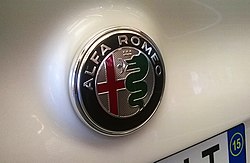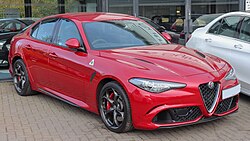| Engine and transmission | Displacement | Max. power
(CE) [42] | Peak torque
(CE) [42] | Top speed | 0–100 km/h (0–62 mph) (seconds) | Combined consumption
(CE) [42] | CO2 emissions
(CE) [42] | Notes |
|---|
| Petrol engine range |
|---|
| 2.9 L 90° 24v twin-turbocharged V6 AT8 "690T" | 2,891 cc (176.4 cu in) | 540 PS (397 kW; 533 hp) | 600 N⋅m (443 lb⋅ft) | 300 km/h (186 mph) | 3.6 | 10.8 L/100 km (26 mpg‑imp; 22 mpg‑US) [74] | 274 g/km [75] | GTA announced in 2020 |
| 2.9 L 90° 24v twin-turbocharged V6 AT8 "690T" | 2,891 cc (176.4 cu in) | 540 PS (397 kW; 533 hp) | 600 N⋅m (443 lb⋅ft) | 300 km/h (186 mph) | 3.8 [76] | 10.8 L/100 km (26 mpg‑imp; 22 mpg‑US) [76] | 277 g/km [75] | GTAm announced in 2020 |
| 2.9 L 90° 24v twin-turbocharged V6 AT8 "690T" [77] | 2,891 cc (176.4 cu in) | 520 PS (382 kW; 513 hp) [63] | 600 N⋅m (443 lb⋅ft) | 307 km/h (191 mph) | 3.9 [78] | N/A | N/A | Limited Racing edition with Akrapovic exhaust, announced 2019
MY2024 |
| 2.9 L 90° 24v twin-turbocharged V6 MT6 "690T" [15] | 2,891 cc (176.4 cu in) [42] | 510 PS (375 kW; 503 hp) at 6,500 rpm [44] | 600 N⋅m (443 lb⋅ft) at 2,500–5,500 rpm [79] | 307 km/h (191 mph) [44] | 3.9 [30] | 8.5 L/100 km (33 mpg‑imp; 28 mpg‑US) [44] | 198 g/km [44] | Only available in left-hand-drive countries (except North America). |
| 2.9 L 90° 24v twin-turbocharged V6 AT8 "690T" | 2,891 cc (176.4 cu in) [42] | 510 PS (375 kW; 503 hp) at 6,500 rpm [44] | 600 N⋅m (443 lb⋅ft) at 2,500–5,500 rpm [79] | 307 km/h (191 mph) [44] | 3.9 | 8.2 L/100 km (34 mpg‑imp; 29 mpg‑US) [80] | 189 g/km | Available in all markets. |
| 2.0 L turbocharged I4 GME MultiAir AT8 Q4 [81] | 1,995 cc (121.7 cu in) | 280 PS (206 kW; 276 hp) at 5250 rpm | 400 N⋅m (295 lb⋅ft) at 2,250–4,500 rpm | 240 km/h (149 mph) [79] | 5.2 | 6.4 L/100 km (44 mpg‑imp; 37 mpg‑US) | 152 g/km | |
| 2.0 L turbocharged I4 GME MultiAir AT8 Q2 [82] | 1,995 cc (121.7 cu in) | 280 PS (206 kW; 276 hp) at 5250 rpm | 400 N⋅m (295 lb⋅ft) at 2,250–4,500 rpm | 240 km/h (149 mph) | 5.7 | 6.4 L/100 km (44 mpg‑imp; 37 mpg‑US) | 144 g/km | Available in German market. |
| 2.0 L turbocharged I4 GME MultiAir AT8 | 1,995 cc (121.7 cu in) | 250 PS (184 kW; 247 hp) at 5250 rpm< | 400 N⋅m (295 lb⋅ft) at 2,250–4,500 rpm | n/a | n/a | n/a | n/a | 2020 Italian market. "Superbollo tax model" [83] |
| 2.0 L I4 GME turbocharged MultiAir AT8 | 1,995 cc (121.7 cu in) [84] | 200 PS (147 kW; 197 hp) at 5,000 rpm | 330 N⋅m (243.4 lb⋅ft) at 1,750 rpm | 235 km/h (146 mph) | 6.6 [85] | 5.9 L/100 km (48 mpg‑imp; 40 mpg‑US) | 138 g/km | |
| Diesel engine range |
|---|
| 2.2 L I4 Multijet II AT8 Q4 [86] | 2,143 cc (130.8 cu in) | 210 PS (154 kW; 207 hp) [86] | 470 N⋅m (347 lb⋅ft) at 1,750 rpm | 235 km/h (146 mph) | 6.9 | 4.7 L/100 km (60 mpg‑imp; 50 mpg‑US) | 122 g/km | MY2019 |
| 2.2 L I4 Multijet II AT8 Q4 [87] | 2,143 cc (130.8 cu in) | 180 PS (132 kW; 178 hp) | 450 N⋅m (332 lb⋅ft) at 1,750 rpm | 230 km/h (143 mph) | 6.8 | 4.7 L/100 km (60 mpg‑imp; 50 mpg‑US) | 122 g/km | 2015-2018 |
| 2.2 L I4 Multijet II AT8 [86] | 2,143 cc (130.8 cu in) | 180 PS (132 kW; 178 hp) [86] | 450 N⋅m (332 lb⋅ft) at 1,750 rpm | 230 km/h (143 mph) | 7.1 | 4.2 L/100 km (67 mpg‑imp; 56 mpg‑US) | 109 g/km | 2015-2018 |
| 2.2 L I4 Multijet II AE AT8 [86] | 2,143 cc (130.8 cu in) | 180 PS (132 kW; 178 hp) at 3,750 rpm [86] | 450 N⋅m (332 lb⋅ft) at 1750 rpm | 230 km/h (143 mph) | 7.2 | 3.8 L/100 km (74 mpg‑imp; 62 mpg‑US) | 99 g/km | 2015-2018 |
| 2.2 L I4 Multijet II MT6 [86] | 2,143 cc (130.8 cu in) | 180 PS (132 kW; 178 hp) at 3,750 rpm [86] | 380 N⋅m (280 lb⋅ft) at 1,750 rpm | 230 km/h (143 mph) | 7.2 | 4.2 L/100 km (67 mpg‑imp; 56 mpg‑US) | 109 g/km | 2015-2018 |
| 2.2 L I4 Multijet II AT8 [65] | 2,143 cc (130.8 cu in) | 190 PS (140 kW; 187 hp) at 3,750 rpm [86] | 450 N⋅m (332 lb⋅ft) at 1,750 rpm | 230 km/h (143 mph) | 7.1 | 4.9 L/100 km (58 mpg‑imp; 48 mpg‑US) | 128 g/km | MY2019 |
| 2.2 L I4 Multijet II AT8 Q4 [65] | 2,143 cc (130.8 cu in) | 190 PS (140 kW; 187 hp) at 3,750 rpm [86] | 450 N⋅m (332 lb⋅ft) at 1,750 rpm | 230 km/h (143 mph) | 7.1 | 5.5 L/100 km (51 mpg‑imp; 43 mpg‑US) | 145 g/km | MY2019 |
| 2.2 L I4 Multijet II MT6 [86] | 2,143 cc (130.8 cu in) | 150 PS (110 kW; 148 hp) at 4,000 rpm [86] | 380 N⋅m (280 lb⋅ft) at 1,500 rpm | 221 km/h (137 mph) | 8.4 | 4.2 L/100 km (67 mpg‑imp; 56 mpg‑US) | 109 g/km | 2015-2018 |
| 2.2 L I4 Multijet II AT8 [86] | 2,143 cc (130.8 cu in) | 150 PS (110 kW; 148 hp) at 4,000 rpm [86] | 450 N⋅m (332 lb⋅ft) at 1,750 rpm | 221 km/h (137 mph) | 8.2 | 4.2 L/100 km (67 mpg‑imp; 56 mpg‑US) [88] | 109 g/km | 2015-2018 |
| 2.2 L I4 Multijet II AT8 [65] | 2,143 cc (130.8 cu in) | 160 PS (118 kW; 158 hp) at 4,000 rpm | 450 N⋅m (332 lb⋅ft) at 1,500 rpm | 221 km/h (137 mph) | 8.2 | 4.9 L/100 km (58 mpg‑imp; 48 mpg‑US) | 128 g/km | MY2019 |
| 2.2 L I4 Multijet II MT6 [86] | 2,143 cc (130.8 cu in) | 136 PS (100 kW; 134 hp) at 4,250 rpm [89] | 380 N⋅m (280 lb⋅ft) at 1,500 rpm | 210 km/h (130 mph) | 9.0 | 4.2 L/100 km (67 mpg‑imp; 56 mpg‑US) | 109 g/km | 2015-2018 Offered only in some EU markets, for tax reasons |
| 2.2 L I4 Multijet II AT8 [90] | 2,143 cc (130.8 cu in) | 136 PS (100 kW; 134 hp) at 2,500 rpm | 450 N⋅m (332 lb⋅ft) at 1,750 rpm | 210 km/h (130 mph) | 9.5 | 4.8 L/100 km (59 mpg‑imp; 49 mpg‑US) | 128 g/km | MY2019 Offered only in some EU markets, for tax reasons |
| Note: AT6 6-speed automatic transmission, MT6 6-speed manual transmission, AT8 8-speed automatic transmission, Q4 all-wheel drive |






















